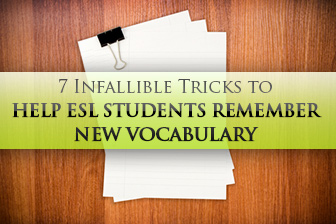As we strive to help students improve English fluency, words are one of the basic buildings blocks.
They are the principal carriers of meaning in speech and without them, students simply can’t communicate. Introducing vocabulary to ESL students is usually not a problem. We try to elicit vocabulary as much as we can. Still, despite our best efforts, students don’t remember as many words as we’d like them to. Lots of new words are understood when introduced, but then disappear into oblivion. How can we help students remember (and use) more words? Try these tricks.

How to Help Your ESL Students Remember New Vocabulary
-
1
Always teach vocabulary in context
You’ve probably heard this again and again (especially from me!) but it can’t be emphasized enough. The first step in helping students remember vocabulary is teaching it in context. This means you should never provide a list of isolated, and least of all unrelated words, for them to learn. Words should be introduced within the context of a story, everyday situation, sport, activity or any context your students are familiar with.
Try this: We often teach words related to weather with pictures of clouds, rain, sun, etc…and that’s perfectly fine, but try this instead. Print out the Weather Channel’s 10-day forecast. Talk about what the weather will be like today, tomorrow and the day after tomorrow. Will there be any thunderstorms in the next 10 days? When that storm hits you can be sure your students will remember the word “thunderstorm”.
-
2
Use the right timing for repetition
There are plenty of scientific studies and papers on vocabulary teaching and learning, but let me summarize the results. Most studies agree that it is essential to repeat or practice a new set of words immediately after being exposed to them. And then repetition should follow at progressively longer intervals. So, to ensure that students will remember the words you teach them, they must use them again – and again.
Try this:
- Use new words immediately after they are introduced (introduction followed by practice)
- Use them again one hour later (quick review at the end of class)
- Use them again one day later (review the words they learned the previous day)
- Use them one week later (general review of words learned in the previous week)
- Use them one month later (review/preparation for a test)
-
3
Use pictures and visuals whenever you can
When we speak, words are gone with the wind – they disappear in a matter of seconds. Students may understand them, but their minds are quickly filled with other thoughts. Our brains, however, are wired to process visual information differently – it sticks, whether we are visual learners or not.
Try this: Whenever possible use flashcards, pictures, or posters when introducing new words. Use the same visuals, or different ones, to test students’ memory of the words previously taught.
-
4
Make the words memorable
By definition, “memorable” event or occasion is easily remembered. By the same token, you can make new words more “memorable” by using techniques that engage students and get their attention.
Try this: Introduce vocabulary related to feelings by making exaggerated faces. It will make your students laugh, and chances are they’ll remember them more. The same thing will happen if you draw funny pictures on the board or use realia. These types of experiences are memorable for students, which makes the vocabulary you use easier to remember as well.
-
5
Use Word Clusters or Webs
Organize words into word clusters, and it’ll help students create associations between words. For each set of new words, create the first cluster together, then for future clusters have students recreate them on their own.
Try this: Let’s suppose you have taught animals in different lessons throughout the year. Write the word “animals” at the center of your cluster and let students branch out from there by supplying different types of animals, like farm, jungle, domestic animals. Students then continue by naming the different animals in each category.
-
6
Use words in phrases or collocations
When practicing new words, make sure students not only remember the “word” itself but its proper collocation or usual verb-noun combination.
Try this: When teaching Business English, don’t just teach words like “appointment”, “contract” or “meeting”, teach phrases like “make an appointment”, “sign a contract” or “cancel a meeting”.
-
7
Practice out loud
Quite often we give students vocabulary exercises to complete, and while this is important to help them practice writing the new words, studies also show that practicing words out loud is more effective in improving retention than practicing them silently. Apparently, the ear is an important ally when it comes to remembering vocabulary.
Try this: Games are a great way to practice vocabulary out loud. Play this Clothing Memory Game but make sure students make sentences with the words. Or try a game like Guess the Sport.
Most students have no trouble comprehending new vocabulary; the problem is getting them to remember to use these new words.
All we have to do is give them the opportunities to put what they’ve learned to practice.
Do your students remember most of the vocabulary they are taught?
P.S. If you enjoyed this article, please help spread it by clicking one of those sharing buttons below. And if you are interested in more, you should follow our Facebook page where we share more about creative, non-boring ways to teach English.







